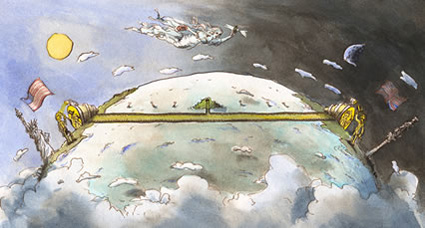A fantastical Victorian device enabling Londoners to see America is coming to life, created by artist Paul St George and produced by Artichoke, the creative group that brought The Sultan”™s Elephant to London 2 years ago.
Tower Bridge, London SE1
May 22-June 15
This way to New York – through a 40ft-long Telectroscope
by Robert Gore-Langton
The Times
May 3, 2008
The story goes that an eccentric Victorian engineer called Alexander Stanhope St George invented a mysterious device called a Telectroscope. This would allow its users to communicate visually over long distances via a network of tunnels – a kind of steam-age webcam.
St George”™s fanciful project came to nought. But his great-grandson, the tricksy British artist Paul St George, says that he has discovered the existence of the Telectroscope in the family archives, and has set about completing it using modern technology.
His 21st-century Telectroscope will allow people at one end in London to see those at the other, in New York. It opens later this month, just by Tower Bridge.
Jutting into the ground will be a 40ft-long (12m) Victorian-styled tubular optical instrument, 6ft in diameter. It will look something like a giant”™s telescope. The device is so large that its maker had to take the other end to New York by ship. The twin machine will be sited near the Brooklyn Bridge.
For £1 a go, people will be able to wave down a massive viewing pipe into the earth and see others in New York waving back. Its aperture is so wide that two or three families can look down it at the same time.
If it”™s not theatre as we know it, it should certainly be a great spectacle. The idea is that viewers at one end will become performers at the other, and vice versa. People will wave, gesture (and possibly moon) and generally communicate silently across thousands of undersea miles.
St George is nothing if not mischievous: the press release for this project was issued on April 1. But, rummy as it may sound, the machine, he insists, is no hoax and the people you see will be genuinely in New York, not actors on the other side on the Thames.
So how will the device work? There is a useful clue in the artist”™s blog, which refers to the manner in which the Victorians laid the transatlantic cables for the early telegraph system.
St George won”™t admit it directly, but his Telectroscope might just use the modern-day version of the telegraph, broadband internet cable, to transmit video images between the two venues at high speed. If his version lacks some of the mystique of his great-grandfather”™s, it should be no less fun for those involved.
One reason why this transatlantic event is so eagerly anticipated is that it is produced by Artichoke, the creative – and disruptive – outfit that brought us The Sultan”™s Elephant, a 42-tonne mechanical pachyderm with a giant puppet girl that was such a sensational traffic stopper in Central London two years ago.
Nicky Webb, Artichoke”™s director, was intrigued by the possibility of presenting the Telectroscope as its next outdoor project. “After we”™d done the elephant, we wanted something as quirky and unusual. We had never heard of Paul, but when we met up we saw the twinkle in his eye and the kernel of an idea for something that special. As with the elephant, we want to make people feel they are on holiday in their own city.
“You are not going to spend four hours looking down this Telectroscope, but there are all sorts of lovely possibilities: you could arrange to meet friends in New York or even propose marriage down it! [Albeit in sign language, presumably]. Schools in Southwark and New York will be twinning up and using it. Its aim is to be something huge, impressive and magical.”
“The Telectroscope started off as a totally unintentional hoax in the 1870s,” explains St George, who is the leading expert on this forgotten backwater of Victorian technology. “It came about through an error. A French editor misread a report about the invention of a thing called the Electroscope – which is all to do with static electricity – and called it a Telectroscope. He also misinterpreted its purpose.
“The fascinating thing is that his misunderstanding of what it did – to communicate face to face over a vast distance – really caught fire. People really liked the idea, which promised what was called “˜the suppression of absence”™. Mark Twain and other writers became fascinated by it.”
The unbuilt fantasy Telectroscope was so popular that it produced, in 1879, a cartoon in Punch in which a Pooter-like couple sit watching a screen over the mantelpiece as they “converse gaily with their children in the Antipodes”. It was a drawing-room joke, but one that represented a theoretical protype for the videophone or the webcam. Various countries claimed to have invented a Telectroscope but St George”™s putative ancestor was the only one to invent a device that had practical potential.
Whatever its workings, the proof of this machine will be in the viewing. But if its impact is half that of the Sultan”™s Elephant, it will have Londoners talking for years to come. And it”™s rather nice to know that the whole arcane project originally started life as a Victorian typing error.
Thanks Erin
Related link:

